The Continuum Fingerboard
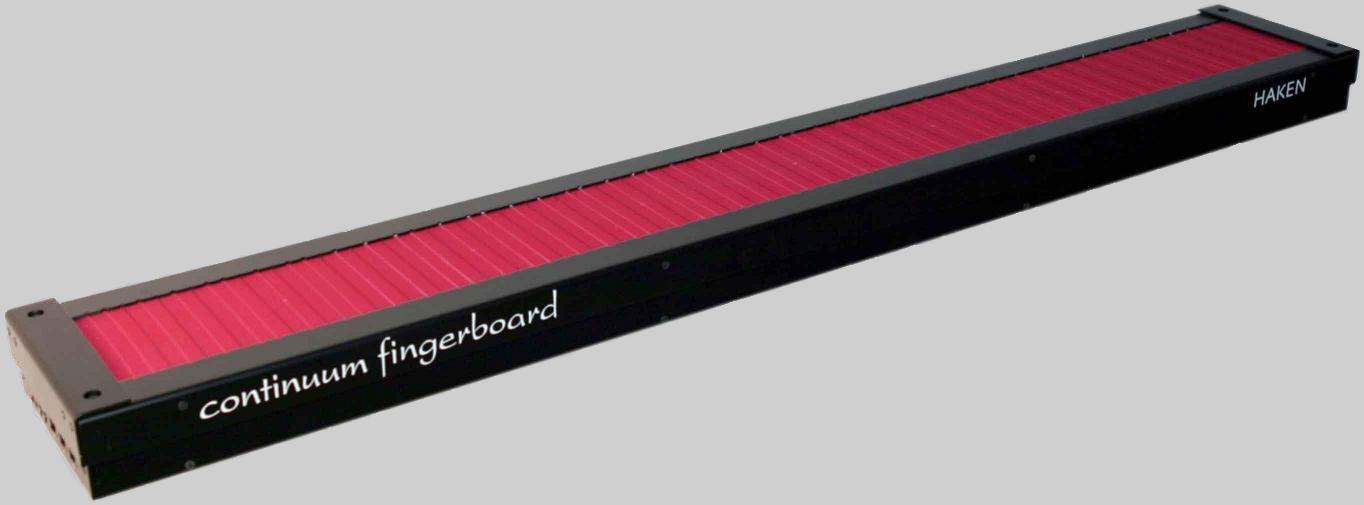
The Continuum Fingerboard, designed by Dr.
Lippold Haken, is a music controller that is continuous in three dimensions. I helped Lippold out
on some of the early prototypes: I wrote some C code for a small version and designed the circuit
boards for the first full-scale prototype.
But these days I just play it!
You can read much more about it on the Haken Audio site.
The three dimensions are X (left to right, typically used for pitch), Y (toward or away from the player),
and Z (how hard you are pushing down, often used for volume). I have created some sound files
demonstrating its expressive capabilities:
Reaktor Creations for the Continuum
Continuum Tuning Downloader
Textured Surfaces for the Continuum
Dedicated Instant Round Pedal
Examples
Continuum with Lou DiBello
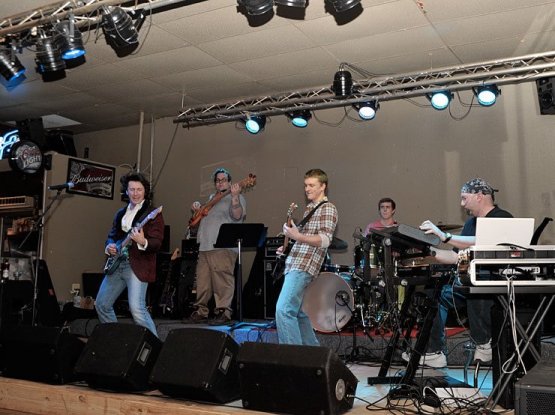
|
I've been playing keyboard and Continuum with the Lou DiBello band since summer 2011, using
it to make horn sounds and to add multiple guitar harmonies from Lou's studio recordings.
Tribute
In Lou's tribute to Yngwie Malmsteen, I'm using the Continuum to do dual leads with Lou.
See the video on YouTube
Auld Lang Syne
In this version, I use a modified version of the
big band synthesizer to do
Queen-like guitar harmonies. See the video on YouTube
|
Handel on the Continuum
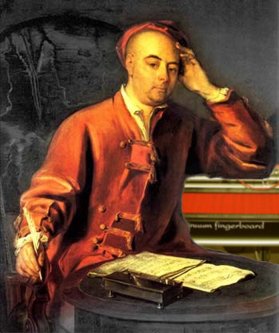
|
I did this multi-track version of "Alla Hornpipe" using the Continuum and Native Instruments' Reaktor.
See the video on YouTube
|
Not-Too-Serious Moog Solos with a Band
These are from a session at Pogo Studio where I had the
Continuum and CVC controlling Mark Rubel's 1968 Moog synthesizer.
I had fun using the Y output
to control filter cutoff and twiddling knobs on the Moog at the same time for other effects. With the Continuum, you can make a
synth kinda sound like it's talking (similar to how Jimi Hendrix did it with his guitar and wah-wah pedal).
The rest of the band is Mark Ginsberg on
guitar, John Tubbs on bass, and Mike Powers on drums. The engineering was by Mark Rubel and his students while we
were acting as guinea pigs for his recording class. Yes, that's THREE Mark's. That situation can get confusing.
(At a different guinea pig session, we had drummer Mark McKnight and there was a Mark in the class, for a total
of FIVE Marks. I digress.)
Hear it: (1.8 MB mp3)
Funky-Axxe Bass
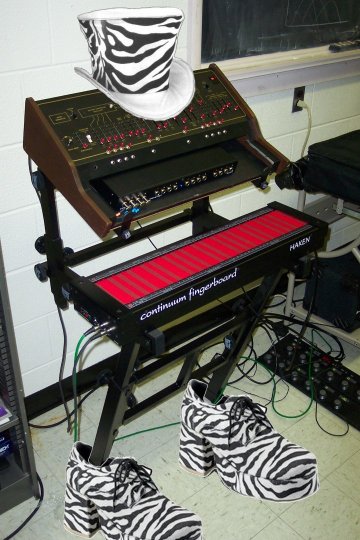
|
Another couple of jam excerpts recorded at Pogo Studio with me
using the Continuum to drive the ARP Axxe
with built-in CVC,
creating a bass sound. (The bass player had cancelled at the last minute). The blindingly fast response of the
CVC makes it fun to do percussive things like this. Mark Ginsberg is on guitar and Gordon Kay on drums. In
the second part you can hear the Axxe's Y-controlled
growl modification in action.
Hear it: (3.1 MB mp3)
|
New York Times Article
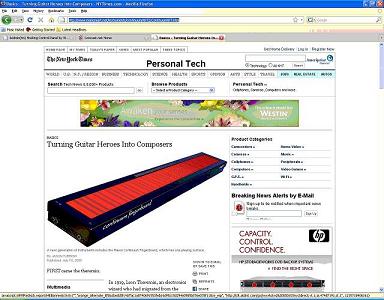
The Continuum was discussed in a
New York Times article
about alternative music controllers. I created a mirror page of it for when it
is taken down off of the NYT site.
Indiana Jones

John Williams and
Randy Kerber used the Continuum to play some of the main melodies in the score for
Indiana Jones and the Kingdom of the Crystal Skull.
Here is the page on the Haken Audio site with excerpts and info.
Tesla's Continuum
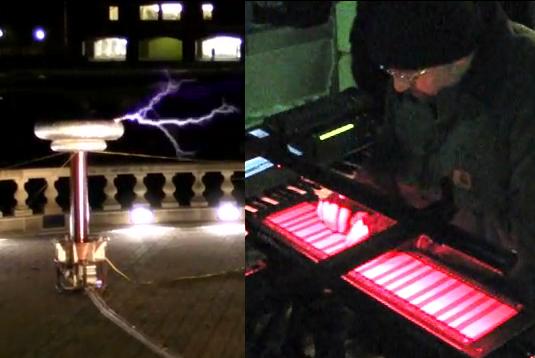
For the 2008 Engineering Open House at the University of Illinois, we
did an outdoor concert with the Continuum driving a Tesla coil.
See the video.
ContinuMoog
Here are a couple of recordings where I used the Continuum's new
CVC analog interface to control
the Moog modular synthesizer
at Pogo Studio here in Champaign, Illinois.
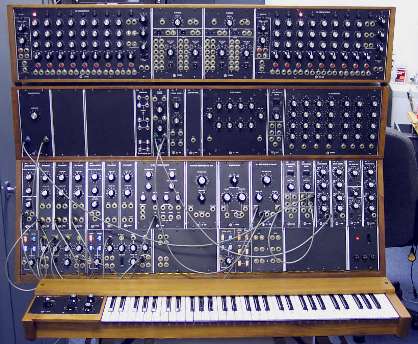
All Blues
Here, I'm using the ContinuMoog ito imitate Miles Davis' trumpet on the classic jazz tune All Blues. The saxophones
were also played on the Continuum, driving the software synth
Reaktor via MIDI. The
bass/drums background was made with the Jazz Looping Pedalboard.
I used Ableton Live to do the looping.
Hear it: (2462K mp3)
Warm Valley
In this recording, I am using the ContinuMoog to do my best impersonation of the alto saxophone master
Johnny Hodges
playing on Duke Ellington's beautiful tune Warm Valley.
The guitar/bass/drums background was once again made with the
Jazz Looping Pedalboard.
Hear it: (1022K mp3)
Funk Loops
This example was part of my Continuum demo for NAMM 2006 and the
Engineering Open House at the University of Illinois. All the sounds but the drums came from Native Instruments'
Reaktor software running as a VST plugin inside Ableton Live for the looping. The looped
parts are as follows:
-
1. Pre-recorded Battery Drum Loop.
-
2. Bass sound controlled with the Continuum's Mono mode, in which the notes re-trigger when you
switch to a different finger.
-
3. Chords controlled by the Continuum in Poly mode. The front-back (Y) direction is controlling
filter cutoff.
-
4. Guitar sound demonstrating all three of the Continuum's monophonic modes in succession:
-
a. Legato: sounds like Eddie Van Halen tapping.
-
b. Retrigger: sounds like speed picking.
-
c. Portamento: sounds like whammy bar effects.
Hear it: (1356K mp3)
Legato Saxophone
I used the Continuum's recently-improved monophonic legato to control a Reaktor
saxophone sound in this version of Duke Ellington's beautiful ballad "In a Sentimental Mood".
Pressure (Z) controls volume & brightness, and the front-back (Y) direction controls the
depth of "growl". I created the guitar/bass/drums background with the
Jazz Looping Pedalboard.
Hear it: (2125K mp3)
Drone & Solo
In this example, the Continuum is used in 6-voice polyphonic mode with no pitch rounding, driving a synth ensemble I created with Native Instruments' Reaktor software. In poly mode, each voice is sent on a different MIDI channel so that pitch bend information affects only one voice and polyphonic pitch bending is possible. This particular synth sound uses two square-wave oscillators per voice, with the oscillators tuned in fifths, and uses the Continuum's "Y" information to control filter cutoff. I added chorus, delay, and reverb in Cubase. One great thing you can do with the Continuum is to play justly-intonated tones above a drone sound.
Hear it: (1218K mp3)
RoboTenor
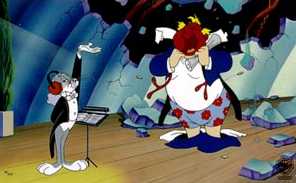
Here the Continuum is used mono mode with no pitch rounding, driving my Nord Modular. The synth patch uses the Nord's"Vocal Filter" module to simulate a human voice which morphs between "Ahhh" and "Eeee" in response to the "Y" direction information. All vibrato is obtained manually by sliding the finger from left to right.
Hear it: (1068K mp3)
ContinuFunk
Yes, you can get funky with the Continuum. This was done with overdubs in Cubase. Everything but the drums is my Roland JD-800 played from the Continuum with no time quantization. All sounds were played with the Continuum in "Round Initial Pitches" mode.
|
Lead:
|
X=Pitch
|
Y=Filter Cutoff
|
Z=Nothing
|
|
Clavinet:
|
X=Pitch
|
Y=Filter Cutoff
|
Z=Volume
|
|
Bass:
|
X=Pitch
|
Y=Nothing
|
Z=Volume
|
(Drums: Native Instruments' Battery, Wizoo Basic XXL Drum Kit, Sequenced)
Hear it: (1323K mp3)
Roland Sound Canvas SC-8850
Here are a few short demos using the preset sounds on the Sound Canvas. All demos use "Round Initial Pitches" mode.
-
Fender Rhodes - demonstrates bending, vibrato, chord sliding, brightness control, and soft attack, all achieved merely by modifying playing technique:
Hear it: (594K mp3)
-
Slap Bass - Sounds like Seinfeld.
Hear it: (363K mp3)
-
Fretless Bass - me doing Jaco doing Jimi doing "Third Stone from the Sun".
Hear it: (229K mp3)
In this mp3, the Continuum was used to control my Reaktor Big Band Synthesizer. The Z direction controls volume and brightness of a solo harmon-muted trumpet playing Gershwin's "Summertime":
Hear it: (653K mp3)
Continu-Stick1
With the Continuum it's easy to do very expressive solos with only one hand. In this mp3, I
played the Continuum with the right hand while playing a bass line on
the Chapman Stick with the left hand.
This "Stick Schtick" was part of my demo at the NAMM show in January 2005. Here, the
Continuum is driving a cup-muted trumpet patch on my Nord Modular.
The drum sounds are loops from the
Peter Erskine Living Drums sample CD with
some Battery hits mixed in.
Hear it: (690K mp3)
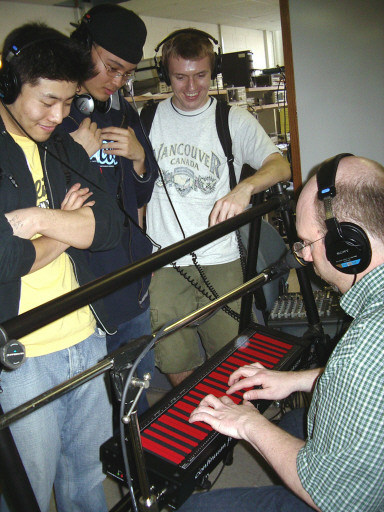
Here is me demonstrating the Continuum at the University of Illinois
2006 Engineering Open House
The NAMM Show
We have shown the Continuum at the winter
NAMM show in Anaheim, California the last 4 years. Here are some pages about the various shows.







